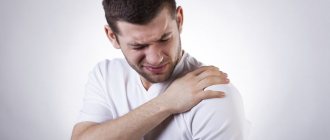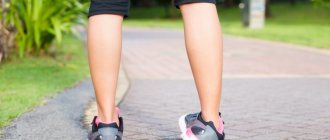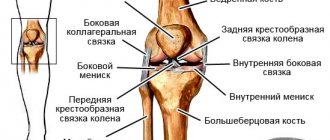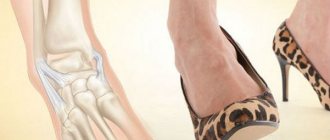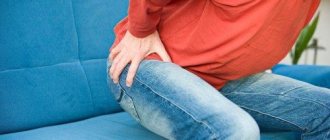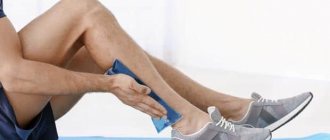© akhenatonimages — stock.adobe.com
Share:
When the inguinal ligaments are sprained, the collagen fibers are partially destroyed, which ensure the anatomically correct position of the thigh relative to the pelvis during leg movements. The maximum angle and amplitude of deviation of the hip joint depends on their elasticity. Injury occurs when the position of the legs changes, which leads to excessive stress on the ligaments and exceeds the permissible limits for changing their length.
The success of restoring performance largely depends on how correctly first aid is provided and how quickly treatment is started.
Causes of injury
A sprain of the inguinal ligaments means damage to the integrity of the tendon fibers that provide attachment to the thigh muscles to the musculoskeletal system.
This fairly common injury often leads to serious consequences and occurs for the following reasons:
- high mobility in the projection of the hip joint;
- bad fall;
- violation of safety precautions during intensive exercises accompanied by jerks;
- inflammation in the tendon area;
- weakening of the inguinal ligament due to impaired mobility of the lower limb;
- existing pathologies of the hip joint: osteoarthritis, arthrosis, arthritis;
- congenital weakness of tissues: tendon and ligament;
- hereditary predisposition.
A sprained groin ligament can occur as a result of turning sharply or moving too vigorously. However, ligaments have the ability to quickly recover: even if completely torn or stretched, they return to their previous shape.
Causes of groin pain in women
Pain in the lower abdomen in the groin in women is most often a symptom of so-called female diseases. Diseases of the reproductive system often occur against a background of general malaise and elevated body temperature. Palpation of the abdomen causes pain.
Pain in the lower groin, caused by an ovarian cyst, is characterized as dull and drawing. They can appear on both the left and right sides. But if the cyst has twisted or burst, the pain becomes acute. Chills and vomiting may occur.
Acute pain in the groin in women can be one of the symptoms of ectopic pregnancy. When an embryo grows in a tube, it presses on the walls throughout its growth, which causes dull periodic pain. If the fallopian tube ruptures, the pain becomes sharp and sharp. This is a wake-up call! It is accompanied by severe internal bleeding and can lead to serious consequences (drop in blood pressure, shock, anemia, etc.).
Pain in the lower groin in women, which accompanies the onset of menstruation, is nagging, aching, gradually increasing and subsiding. It usually goes away after the onset of menstruation.
Pain in the right groin in a woman can be caused by inflammation of the appendicitis, fallopian tube (salpingitis), ovary (oophoritis) and ureter (ureteritis).
Classification by severity
There are 3 degrees of severity of groin sprain:
- I (mild) – the damage does not limit a person’s movement, but only causes minor discomfort.
- II (medium) – the victim experiences mild pain, slightly limiting his movements. Physical exercises such as running, jumping and swinging are no longer available. The injured area may experience blue discoloration and swelling.
- III (severe) – severe pain occurs not only when walking, but also at rest. Stretching is accompanied by swelling, muscle spasms, the formation of hematomas, and often a complete rupture of the ligament occurs.
Depending on the nature of the flow, the form of damage is divided into several types:
- chronic;
- acute;
- subacute
Complete ligament rupture
A complete rupture of the inguinal ligaments is a violation of the integrity of the tendons and muscle fibers. This type of injury is typical for people actively involved in sports.
As a rule, it is expressed by the following symptoms:
- acute pain;
- swelling;
- the appearance of a peculiar crunch in the thigh area;
- hematoma formation due to rupture of capillaries and small vessels;
- the appearance of depressions or swellings under the skin in the affected area;
- severe pain at the slightest movement, making it impossible.
ICD-10 code
According to the international classification of diseases, sprains in the groin belong to the group of diseases T14.3 “Dislocation, stretching and overstrain of the capsular-ligamentous apparatus of the joint of an unspecified area of the body.”
Prevention of inguinal sprains
These exercises can be done at home. However, it is necessary to follow the recommendations of doctors. In this way, rehabilitation of the injured limb can be continued. It takes different lengths depending on the complexity of the disease.
- The recovery period after pathology depends on the severity of the injury, as well as on proper treatment. However, ligament damage can be prevented. To do this, you need to follow certain rules of prevention:
- Before each workout, be sure to warm up;
- You should intensify your lifestyle: walk more often, ride a bike, do not sit in a static position for a long time;
- Groin strains are most common in men, so they need to be as careful as possible;
You need to eat right to ensure your body gets the right amount of carbohydrates.
Symptoms and signs
The main signs of a sprained inguinal ligament:
- a pronounced crunch at the time of injury;
- severe pain of various types: sharp, aching, pulling;
- the appearance of compactions, swelling and swelling in the groin area;
- formation of hematomas;
- an increase in temperature in the damaged area due to the progression of an acute inflammatory process.
The victim may experience pain not only in the groin area, but also in the outer part of the thigh, and mobility in this part is limited. In addition to external manifestations, sprain of the inguinal ligaments entails destruction of the tissue structure of the muscles, tendons and blood vessels. As a result, there is a significant decrease in muscle strength and the appearance of cramps.
Important!
Failure to provide medical care in a timely manner can cause complete immobilization of the legs.
Symptoms appear after a day
External signs of injury appear only the next day or several days later. To avoid complications, it is recommended that immediately after receiving it you contact a specialist who will conduct an external examination and prescribe a diagnosis of the condition of the groin ligaments. Afterwards, the doctor prescribes suitable medications to relieve pain and prevent exacerbation.
Causes of pain in men
Pain in the groin in the lower abdomen in men can cause diseases associated primarily with the human reproductive system. Constant weak, aching pain in the groin in men can be one of the symptoms of diseases of the testicles and their appendages, prostate or benign adenoma.
With inflamed epididymis, pain increases while walking. Inflammation of the prostate gland is characterized by pain of a wide variety of types. They can be sharp, stabbing, aching, often chronic in nature - since many patients do not seek medical help due to fear.
These are the most common reasons why men have groin pain.
First aid
First of all, cold is applied to the damaged area to relieve pain. For this purpose, use ice, a container of cold water, etc. After pain has been eliminated, an elastic bandage is applied to the leg and groin. At the same time, the victim is provided with complete rest: he assumes a horizontal position and does not make any movements.
First aid must be provided within 15 minutes of injury. Timely actions will speed up recovery and reduce the likelihood of complications.
Which doctor should I contact?
First of all, the victim visits a traumatologist, who prescribes an x-ray and, based on the resulting image, determines the degree of damage to the connective tissue fibers. Then he begins treatment himself or refers the patient to other specialists. They may be:
- Physiotherapist - prescribes various types of physiotherapeutic procedures: UHF, magnetic therapy, mud baths, paraffin therapy, etc.
- Massage therapist - conducts a course of therapeutic massages to relieve pain and eliminate swelling. This procedure stimulates the processes of resorption of hematomas and healing of damaged tissues.
- Endoscopist – by inserting an arthroscope into the joint, he receives highly accurate information about the extent of damage.
- Surgeon - performs surgical intervention in severe cases.
- Rehabilitologist – carries out activities aimed at rapid recovery after an injury.
Diagnosis of inguinal ligament sprain
You should not immediately make a diagnosis based on the first symptom. It's better to go to the doctor and get examined. Diagnostics includes the following procedures:
- Radiography. This is only necessary in case of injury or fracture.
- Magnetic resonance imaging or computed tomography. These methods make it possible to study the structure of the affected tissue layer by layer, determine the type of therapy and predict the further development of the pathology.
ULTRASONIC. The presented procedure allows identification of coexisting ligament or muscle injuries.
Features of treatment
Based on the results of the examinations, the specialist determines the method of treating inguinal ligaments. As a rule, drug therapy is prescribed first, and after a while, physical therapy.
Medication
Drug treatment helps with mild to moderate severity. During therapy, the specialist prescribes the following types of drugs:
- Painkillers – quickly eliminate pain.
- Non-steroidal anti-inflammatory drugs - allow you to get rid of unpleasant symptoms. Available in the form of ointments and tablets.
- Anti-inflammatory hormonal - prescribed for serious injuries that cannot be treated with other drugs.
Mild to moderate groin sprains are treated with drugs that have anti-edematous and anti-inflammatory effects:
- Diclofenac;
- Finalgon;
- Dolobene;
- Voltaren;
- Heparin and ichthyol ointment;
- Fastum;
- Deep Relief.
Injections
For serious injuries with severe pain, the patient is prescribed intramuscular injections into the Poupart's ligament using nonsteroidal anti-inflammatory drugs (NSAIDs). The injections have their effect directly at the site of inflammation of the torn fibers. The drugs quickly relieve pain, reduce temperature and eliminate inflammation. The most common means:
- Olfen;
- Revmoxicam;
- Dicloberl;
- Movalis.
Ointments
External medications are safer because they have no contraindications or side effects. There are several types of ointments that have different effects on damaged ligament fibers:
- pain reliever;
- warming;
- anti-inflammatory;
- complex.
Anti-inflammatory drugs block the synthesis of prostaglandins, prevent the appearance of platelets and reduce swelling. The most effective of them:
- Ketoprofen;
- Diclofenac.
Important!
Ointments are applied to the groin area at least 3 times a day until the inflammatory process is completely eliminated.
Lidocaine, Ketonal and Dimexide are used to relieve pain.
Folk remedies
Traditional therapy is effective only for minor injuries. For moderate and severe sprains, they are used as part of a comprehensive treatment.
The most popular options:
- Rub in the ointment obtained by mixing butter with chopped horsetail.
- Apply compresses with a decoction of dry poplar buds or cabbage leaves to the sore spot.
- Prepare an infusion of 50 g marshmallow root, 100 g birch buds, several hop cones and ½ liter of vodka. Use it for compresses for 2 weeks.
- Rub turmeric diluted with water into the affected area every day until it reaches the consistency of sour cream.
Important!
Despite the safety of folk remedies, before starting to use them, consultation with a specialist is necessary.
Taping
The principle of the technique is to glue a tape (a special elastic bandage) to the injured area, supporting the muscle and at the same time allowing it to relax. The procedure requires compliance with a number of rules:
- gluing is carried out on dry and clean skin, avoiding tension;
- The tape is activated (heated) by rubbing.
The injury heals much faster if the ligaments are immobile.
What to do for groin pain
If you have pain in the groin, first of all, diagnosis is important:
- Pay attention to which side it hurts and where it radiates.
- Determine the nature and intensity of pain.
- Pay attention to the frequency of the urge to urinate or defecate.
- Measure your body temperature (the inflammatory process will be accompanied by an increase in temperature).
- Pay attention to your general health, the presence of nausea.
- Measure your blood pressure.
- If you're an athlete, reconsider your workout intensity.
- If you are a woman, pay attention to the timing and nature of your period.
- Be sure to visit a doctor if pain persists.
Remember, sharp pain in the groin is a reason to immediately visit a doctor. Such pain is unlikely to go away on its own.
Nagging pain in the groin in women should prompt you to visit a gynecologist.
Pain in the left groin may indicate a hernia, a pinched nerve in the lower back, inflamed lymph nodes or problems with the intestines; it is worth visiting a therapist.
Rehabilitation methods
During the recovery period, physical exercise is permissible only with good tests and with the permission of a doctor. Exercises are performed at a slow pace to provoke re-injury. Exercise therapy includes the following:
- lifting the knees up;
- walking in place;
- Pull-ups while standing on tiptoes;
- swings performed slowly back and forth;
- imitation of walking while lying on your side.
The duration of physical therapy is no more than 15 minutes a day, especially at the very beginning of recovery.
Recovery time
The recovery process for a sprained groin ligament takes from several days to several months. This period is determined by the severity and individual characteristics of the patient’s body. Sprains cause the greatest harm to men, so their recovery is characterized by a long period of time.
Important!
Lack of exercise and absolute rest significantly accelerate the healing of damaged fibers.
Treatment of groin pain
Diseases of the genitourinary system require adherence to a gentle diet in order to relieve the body a little and help it direct all its strength to fight the pathology. As a rule, the consumption of fatty, spicy and fried foods is limited. There is also a ban on the consumption of alcoholic beverages, coffee, and sweet carbonated water. Lean meat and fish are allowed (in limited quantities), lots of vegetables and fruits. It is recommended to cook food using steam. Break your meals into 5-6 small portions. All this will alleviate the symptoms of the disease.
For pain caused by bloating, eliminate dairy products, flour products (especially white flour), beans and cabbage from your diet.
For muscle pain, limit the load on the area of the injured muscle, provide it with rest and perform massage movements.
If you are prone to urolithiasis, drink a lot. Water reduces the concentration of uric acid and salts in the urine. Drink up to 10 glasses per day.
Remember that proper nutrition can solve and prevent many problems.
Preventive measures
To prevent injury to the groin area, it is necessary to follow simple preventive measures:
- warm up before each workout;
- constantly lead an active lifestyle;
- do not abuse sitting position;
- ensure a regular supply of carbohydrates to the body;
- daily intake of vitamins, especially group B;
- adhere to a proper diet, create a balanced diet.
Sprained inguinal ligaments are rare in everyday life; they are predominantly a sports injury. Therefore, it is important to be able to independently determine the type of damage received during training in order to provide first aid in a timely and competent manner. The duration of treatment and rehabilitation period directly depends on the actions performed immediately after injury.
The main thing is peace
The main factor necessary for muscle recovery after a groin strain is complete rest. That is why the damaged area is fixed with a splint. Sometimes it is quite difficult to apply it yourself, you should consult a doctor. Immediately after an injury, it is better to apply ice or a compress of ice and cold water to the strained muscle. This will remove the pain syndrome. At the second stage, even before contacting a doctor, you should use ointments, rubs or balms. Their functions are anti-inflammatory and soothing. If the pain is unbearable, then analgesics will help. But only a doctor can prescribe them. If the patient’s condition becomes worse, hospitalization cannot be avoided.
The main mistake of those who are trying to help the victim is applying ice or a compress directly to the place where the groin muscle strain occurred. Doctors are categorically against such treatment. A cloth should first be applied to the affected area, and then a compress directly. In this case, the patient must remain calm. Sometimes doctors recommend using crutches to get around after a sprain. They are able to partially protect the ligaments from disturbance.
Examination and diagnosis
An orthopedic traumatologist diagnoses the injury. During the examination, the doctor feels the damaged area, records in the documents the date, time, and environment in which the patient was injured. To determine the severity of the injury and exclude fractures and dislocations, MRI or CT, as well as ultrasound, are prescribed. In some cases, an x-ray is required.
The difference between a sprain and other injuries
Stretching from ruptures and fractures in the groin area is characterized by mild pain that the patient can easily tolerate. Motor activity is maintained at almost 100%. A ligament rupture is indicated by a small pit in the area of damage (the fibers diverge to the sides, exposing the area above the muscles). On palpation this zone sinks.
Mild pain occurs with dislocations, but differs from sprains visually: the incorrect position of the joint is noticeable and to the touch. The leg on the side where the dislocation occurred is somewhat shorter.

